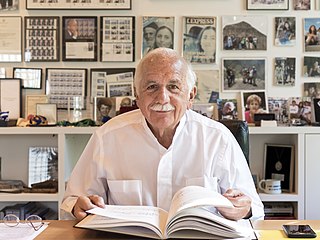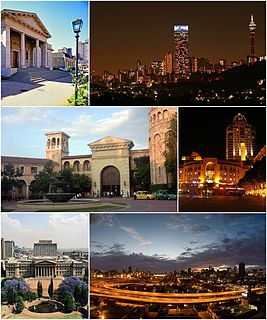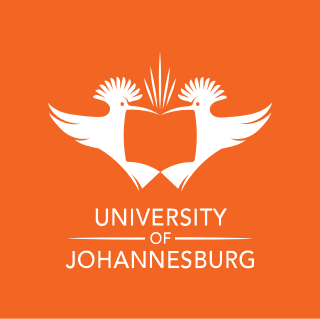Related Research Articles

Moshe Safdie is an architect, urban planner, educator, theorist, and author who claims Israeli, Canadian and American citizenship. Over a 50-year career, Safdie has explored the essential principles of socially responsible design through a comprehensive and humane design philosophy. Safdie is an important architect of the second half of the twentieth and early twenty-first century because of his multiculturalism, commitment to geographic, social and cultural elements that define a place, and constant search for typological and technological innovation. Safdie's projects include cultural, educational, and civic institutions; neighborhoods and public parks; housing; mixed-use urban centers; airports; and master plans for both existing communities and entirely new cities. Safdie has had projects in North and South America, the Middle East, and throughout Asia. He is most identified with designing Marina Bay Sands and Jewel Changi Airport, as well as his debut project, Habitat 67, originally conceived as his thesis at McGill University. This led to his international career. Safdie is considered a thought leader and his exemplary projects have inspired generations of architects and architecture.

Johannesburg, informally known as Jozi, Joburg, or "The City of Gold", is the largest city in South Africa, classified as a megacity, and is one of the 100 largest urban areas in the world. According to Demographia, the Johannesburg-Pretoria urban area is the 26th-largest in the world, with 14,167,000 inhabitants. It is the provincial capital and largest city of Gauteng, which is the wealthiest province in South Africa. Johannesburg is the seat of the Constitutional Court, the highest court in South Africa. Most of the major South African companies and banks have their head offices in Johannesburg. The city is located in the mineral-rich Witwatersrand range of hills and is the centre of large-scale gold and diamond trade. It was one of the host cities of the official tournament of the 2010 FIFA World Cup – and it hosted the final.

Gauteng is one of the nine provinces of South Africa. The name in Sotho-Tswana languages means 'place of gold'.

The University of the Witwatersrand, Johannesburg, is a multi-campus South African public research university situated in the northern areas of central Johannesburg. It is more commonly known as Wits University or Wits. The university has its roots in the mining industry, as do Johannesburg and the Witwatersrand in general. Founded in 1896 as the South African School of Mines in Kimberley, it is the third oldest South African university in continuous operation.

The University of Johannesburg (UJ) is a public university located in Johannesburg, South Africa. The University of Johannesburg came into existence on 1 January 2005 as the result of a merger between the Rand Afrikaans University (RAU), the Technikon Witwatersrand (TWR) and the Soweto and East Rand campuses of Vista University. Prior to the merger, the Daveyton and Soweto campuses of the former Vista University had been incorporated into RAU. As a result of the merger of Rand Afrikaans University (RAU), it is common for alumni to refer to the university as RAU. The Vice-Chancellor and Principal of UJ is Professor Tshilidzi Marwala who took office on 1 January 2018. Between 2005 and 2017, UJ's Vice-Chancellor and Principal was Prof Ihron Lester Rensburg.

Sir Herbert Baker was an English architect remembered as the dominant force in South African architecture for two decades, and a major designer of some of New Delhi's most notable government structures. He was born and died at Owletts in Cobham, Kent.

Roedean School for Girls is a private English medium and boarding school for girls situated in the suburb of Parktown in the city of Johannesburg in the Gauteng province of South Africa.

Rex Distin Martienssen ARIBA CIAM was a South African architect who was greatly influenced by Le Corbusier and spearheaded a modernist architectural movement in South Africa.
Sir Gerhard Jacob Zunz was a British civil engineer and former chairman of Ove Arup & Partners. He was the principal structural designer of the Sydney Opera House.

Johannesburg Park Station is the central railway station in the city of Johannesburg, South Africa, and the largest railway station in Africa. It is located between the Central Business District and Braamfontein, in the block bordered by Rissik, Wolmarans, Wanderers, and Noord Streets. Park Station lies on the main Witwatersrand railway line that runs East-West from Krugersdorp to Germiston. The first four stations to the east are Doornfontein, Ellis Park, Jeppe and George Goch Stations.
Ruth Sacks is a South African artist who lives and works in Johannesburg. She is currently a postdoctoral researcher in the South African Research Chair Initiative (SARChI) for Social Change at Fort Hare University. Sacks holds a PhD (Arts) from the University of the Witwatersrand where she was a fellow at the Wits Institute for Social and Economic Research (WiSER). Her third artist book, Twenty Thousand Leagues Under Seas, was launched in 2013. She is a laureate of the HISK in Ghent. She was one of the facilitators of the artist-run project space the Parking Gallery, hosted by the Visual Arts Network of South Africa (VANSA) in Johannesburg. Ruth Sacks' work has been presented internationally in venues such as the African Pavilion at the 52nd Venice Biennalein 2007, the ZKM Centre for Art and Media, Karlsruhe in 2011 and the National Museums of Kenya, Nairobi in 2017.
Katherine Maree Otten, usually known as Kate Otten, is a South African architect, who has won numerous awards for her South African traditional work.
The following is a timeline of the history of the city of Johannesburg, in the Gauteng province of South Africa.
Steffen Ahrends was an architect. His father is the architect Bruno Ahrends. Peter Ahrends, son of Steffen Ahrends, is also an architect, based in Dublin, Republic of Ireland.
Hilary Claire (1941-2007) was an English-South African anti-apartheid activist, educationist and writer.

Irvy (Igle) Gledhill is a South African physicist at the University of Witwatersrand, School of Mechanical, Industrial & Aeronautical Engineering, in Johannesburg.
Ernest Willmot Sloper was an architect active in Johannesburg, South Africa and in the United Kingdom. He designed Bishopskop for Michael Furse, bishop of Pretoria. He also designed his own house in Parktown, Endstead

Joseph Moses Gerald Gordon was a prominent South African architect, Professor (1976–1994) at the University of Witwatersrand School of Architecture, and Honorary Research Fellow of the university (1994-2016). He is best known for inventing the "Thin-Skin" building method. His papers and drawings are archived at the University of the Witwatersrand School of Architecture & Planning. He was president of the Transvaal Institute of Architects in 1978 and 1979. His residential home was commemorated with a "Blue Plaque" by the Johannesburg Heritage Foundation in 2021.
Bronwyn Law-Viljoen is a South African writer, editor, publisher and professor. She is the co-founder of the publisher Fourthwall Books and her own bookstore called Edition. She acts as the primary editor for works on law and history of South Africa and the architecture and building process of its constitutional court structures, along with artistic book publications of the work of William Kentridge. She has also published her own novel called The Printmaker.
References
- 1 2 "Book of South African Women: Architects", Mail and Guardian online, 3 August 2009. Retrieved 11 February 2012.
- ↑ "The Team", Sarah Calburn Architects. Retrieved 11 February 2012.
- ↑ "Sarah Calburn – Matric Class 1981", Roedean School. Retrieved 11 February 2012.
- ↑ "urbaninform Competition : Architecture Contest", e-architect. Retrieved 11 February 2012.